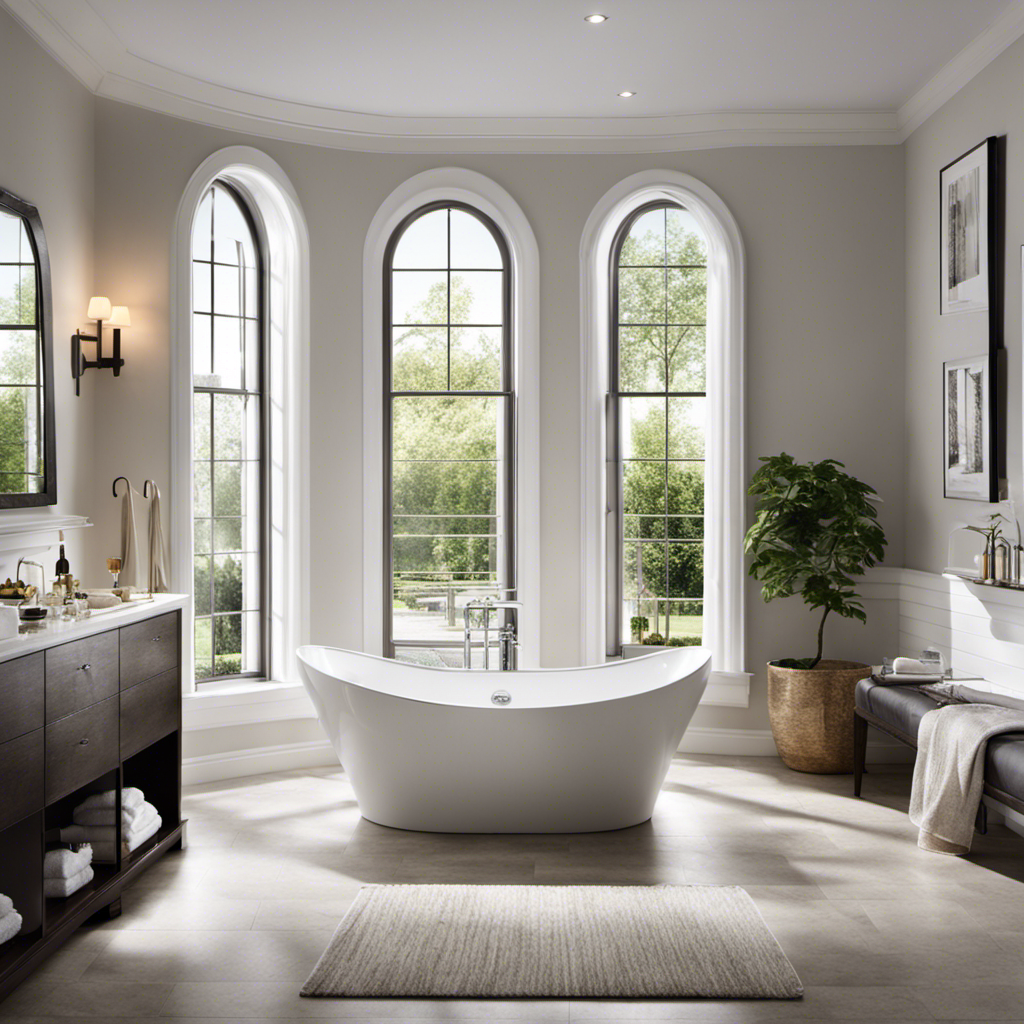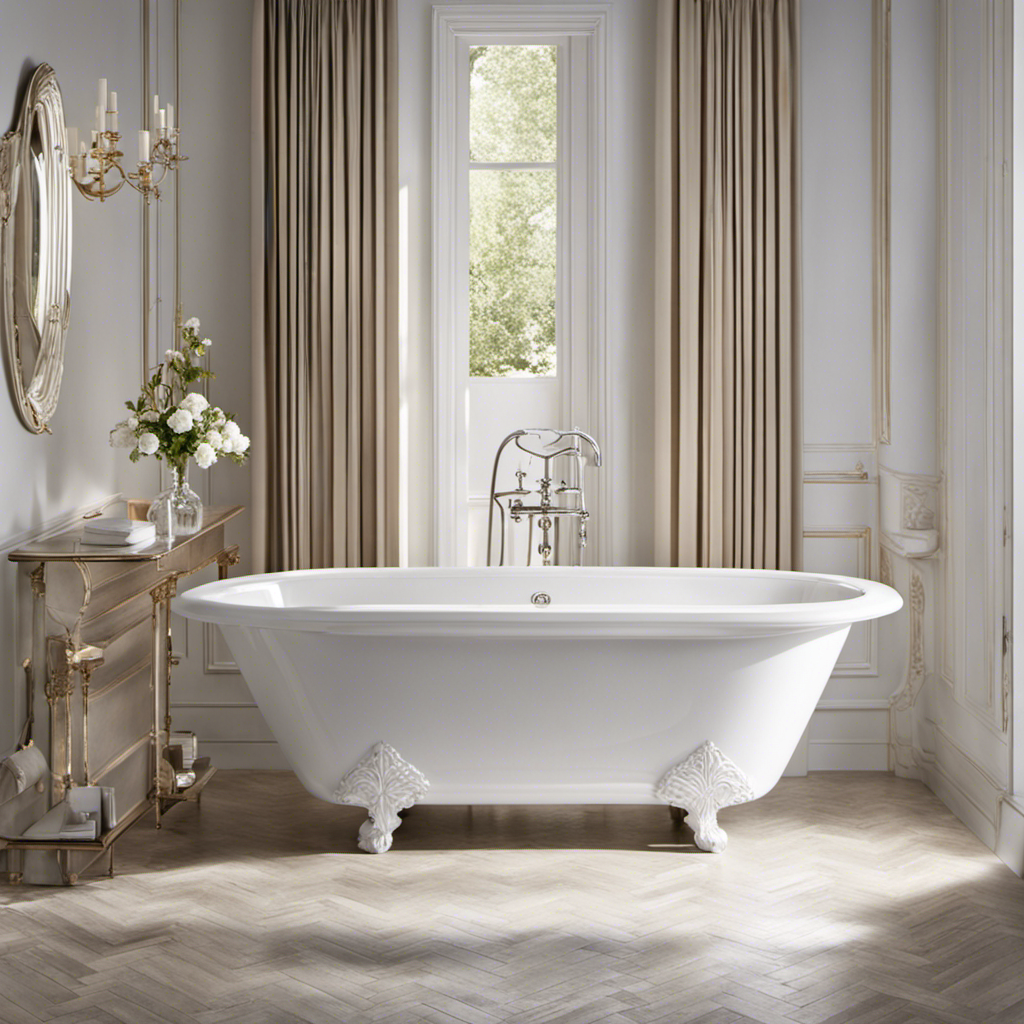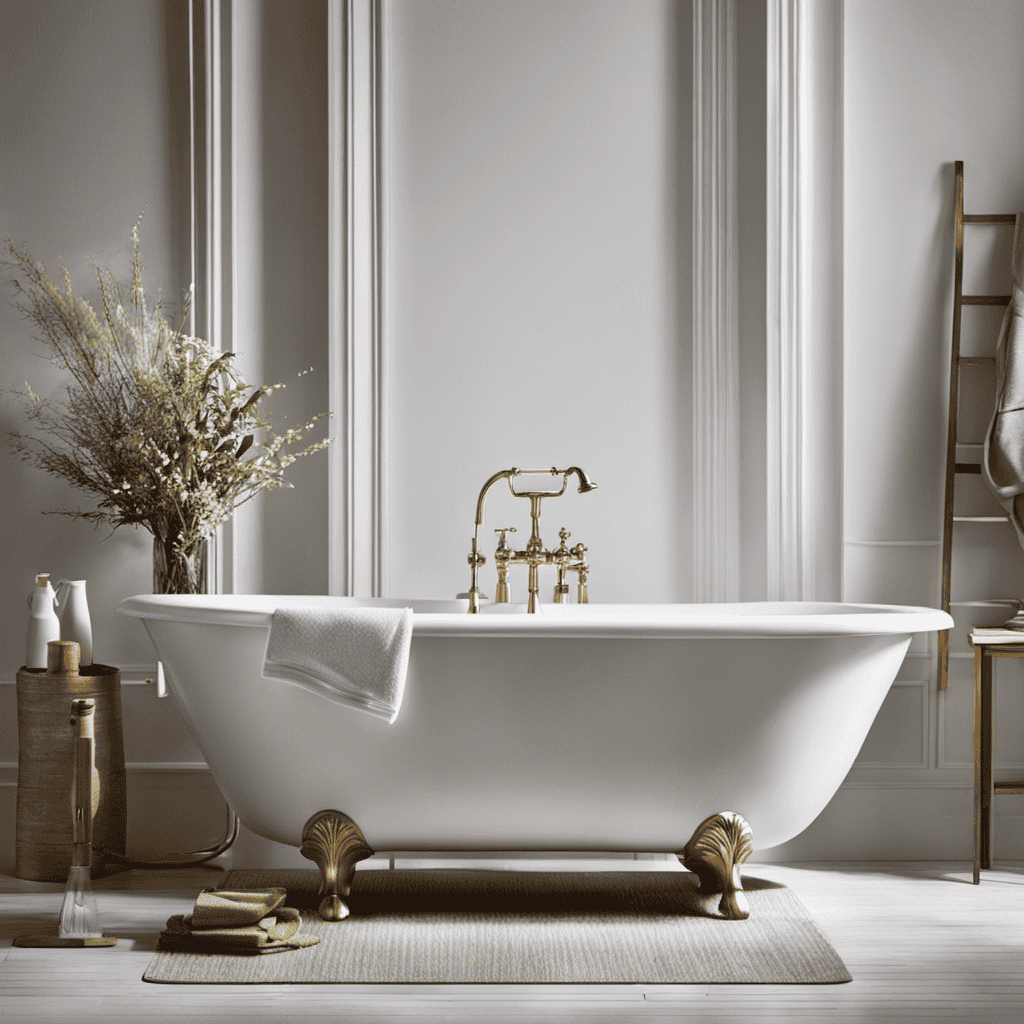Are you tired of squeezing into a tiny bathtub that feels more like a fishbowl than a relaxing oasis? Well, fear not! In this article, we will peel back the curtain on the world of standard bathtubs and explore just how wide they really are.
From industry standards to key factors influencing width, we’ve got you covered. So sit back, relax, and get ready to dive into the world of bathtub widths.
It’s time to make a splash with your bathing experience!
Key Takeaways
- The industry standard for bathtub width is typically around 30 to 32 inches.
- Narrow tubs are typically around 30 inches wide and are ideal for small bathrooms.
- Wide tubs can range from 32 to 42 inches wide and offer more room for relaxation and comfort.
- The choice between narrow and wide tubs should be based on factors such as space constraints, user comfort and accessibility, design preferences, and maximizing bathroom space.
Industry Standards for Bathtub Width
The industry standard for bathtub width is typically around 30 to 32 inches. These dimensions are widely accepted as the common bathtub dimensions and follow the standard bathtub width guidelines.
This width range allows for comfortable soaking and provides enough space for most individuals. It is important to consider the size of the bathroom and the available space before choosing a bathtub.
Additionally, it is essential to check the specific measurements of the bathtub you are interested in, as there may be variations in width among different models and brands.
Now that you understand the industry standard for bathtub width, let’s explore the common width dimensions for standard bathtubs in more detail.
Common Width Dimensions for Standard Bathtubs
When it comes to bathtubs, knowing the popular widths can help you make an informed decision. The ideal bathtub size for you depends on your personal preferences and the space available in your bathroom.
Understanding the differences between narrow and wide tubs can also play a role in determining which option is best for you.
Popular Bathtub Widths
You’ll find that popular bathtub widths can vary depending on the style and brand. When it comes to the ideal width for a bathtub, it ultimately comes down to user preferences.
Some individuals prefer a narrower bathtub, around 30-32 inches wide, which allows for a more compact and space-saving option. On the other hand, some users prefer a wider bathtub, ranging from 34-38 inches, providing a more spacious and luxurious bathing experience.
It’s important to consider your specific needs and space constraints when choosing the width of your bathtub. Additionally, keep in mind that certain brands may offer wider or narrower options within their product lines.
Ultimately, the decision should be based on what will provide you with the most comfortable and enjoyable bathing experience.
Ideal Bathtub Size
There are various bathtub sizes available that cater to different preferences and needs. When it comes to determining the ideal bathtub size, it is essential to consider both the length and width of the tub. Narrow tubs are typically around 30 inches wide, while wide tubs can range from 32 to 42 inches wide. The table below provides a comparison of narrow and wide tubs in terms of their dimensions and benefits:
| Narrow Tub | Wide Tub | |
|---|---|---|
| Length | 60-72 in | 60-72 in |
| Width | 30 in | 32-42 in |
| Benefits | Space-saving, ideal for small bathrooms | More room for relaxation, comfortable for taller individuals |
When selecting a bathtub, consider your space limitations and personal preferences. Narrow tubs are suitable for smaller bathrooms, while wide tubs offer more room to stretch out and relax. Choose the size that best meets your needs and enhances your bathing experience.
Narrow Vs Wide Tubs
Narrow tubs are typically more space-saving and suitable for smaller bathrooms. When choosing the right bathtub width, consider the following:
-
Efficiency: A narrow tub can maximize space utilization, allowing you to have both a bathtub and other necessary fixtures in a compact bathroom.
-
Comfort: Wide tubs provide ample space for relaxation and stretching out, giving you a luxurious bathing experience.
-
Accessibility: Narrow tubs are easier to step in and out of, making them a safer option for individuals with mobility issues or children.
-
Style: Wide tubs can be visually stunning, creating a focal point in your bathroom and adding a touch of elegance.
Considering these factors, you can make an informed decision about whether a narrow or wide tub is right for your bathroom.
Now let’s explore the key factors influencing bathtub width.
Key Factors Influencing Bathtub Width
When considering the width of a bathtub, there are several key factors to take into account.
Firstly, bathroom space constraints play a crucial role in determining the maximum width that can be accommodated.
Secondly, user comfort and accessibility are important considerations, as the width of the bathtub should allow for easy entry and comfortable soaking.
Lastly, design and aesthetic preferences also influence the choice of bathtub width, as different styles and shapes may be preferred based on individual tastes and the overall bathroom design.
Bathroom Space Constraints
Space in a bathroom can be limited, especially when it comes to fitting a standard sized bathtub. However, with careful planning and consideration of your bathroom layout, you can maximize the available space and still have a functional and stylish bathroom.
Here are four key strategies to help you make the most of your bathroom space:
-
Opt for a corner bathtub: Corner bathtubs are designed to fit snugly into the corner of your bathroom, allowing you to utilize the otherwise wasted space.
-
Choose a smaller bathtub: Consider opting for a smaller bathtub that is specifically designed to fit in compact spaces. These tubs are narrower and shorter, making them ideal for smaller bathrooms.
-
Utilize vertical space: Install shelves or cabinets above the bathtub to make use of vertical space for storage. This will help keep your bathroom organized and clutter-free.
-
Use a shower-bathtub combo: A shower-bathtub combo can be a great space-saving solution, as it eliminates the need for a separate shower enclosure.
User Comfort and Accessibility
To ensure user comfort and accessibility in your bathroom, consider incorporating features such as grab bars, a raised toilet seat, and a walk-in shower. These features can greatly enhance the functionality and safety of your bathroom, while also accommodating the needs of individuals with disabilities or limited mobility.
When designing your bathroom, it is important to take into account user preferences and adhere to accessibility standards. For example, grab bars should be strategically placed near the toilet and shower to provide stability and support. A raised toilet seat can make it easier for individuals with mobility issues to use the toilet, while a walk-in shower eliminates the need for stepping over high thresholds, reducing the risk of falls.
Design and Aesthetic Preferences
Now that you understand the importance of user comfort and accessibility when it comes to choosing a bathtub, let’s explore the design and aesthetic preferences that are currently trending in the market.
When it comes to design, there are various options to consider, from modern and minimalist to more traditional styles. To help you make an informed decision, here are some design trends to consider:
-
Freestanding tubs: These elegant and luxurious tubs add a touch of sophistication to any bathroom.
-
Clawfoot tubs: These vintage-inspired tubs create a classic and timeless look.
-
Built-in tubs: These tubs are seamlessly integrated into the bathroom design, offering a sleek and contemporary feel.
-
Walk-in tubs: These tubs are perfect for those with mobility issues, providing easy access and safety features.
In addition to design trends, there are also various material options available, such as acrylic, fiberglass, cast iron, and stone. Each material offers its own unique characteristics in terms of durability, aesthetics, and maintenance requirements. Consider your personal style preferences and the overall look and feel you want to achieve in your bathroom when choosing the material for your bathtub.
Exploring Different Widths of Standard Bathtubs
There’s a wide range of standard bathtub widths to choose from when exploring different options. Bathtub width trends have evolved over the years, with homeowners now favoring wider tubs for a more luxurious bathing experience.
The impact of bathtub width on bathroom design cannot be overstated. A wider bathtub can become the focal point of your bathroom, creating a sense of grandeur and elegance. It can also provide a more comfortable bathing experience, allowing you to fully stretch out and relax.
On the other hand, a narrower bathtub can be a space-saving solution for smaller bathrooms, maximizing the available floor area. Understanding the ideal width for your bathroom is crucial in achieving a visually appealing and functional space that suits your needs.
Understanding the Ideal Width for Your Bathroom
You can determine the ideal width for your bathroom by considering factors such as available floor space and your personal preferences. When it comes to bathtub width trends, there are a few key points to keep in mind:
-
Maximize bathroom space: A narrower bathtub can help you make the most of limited bathroom space, allowing for better utilization of the area.
-
Personal comfort: Consider your own comfort level when choosing the width of your bathtub. Some people prefer a wider bathtub for a more spacious bathing experience.
-
Accessibility: If you have mobility concerns or plan to age in place, a wider bathtub may be a better option to accommodate grab bars or a transfer bench.
-
Visual aesthetics: The width of your bathtub can also impact the overall look and feel of your bathroom. A wider bathtub can create a luxurious and spa-like atmosphere.
With these factors in mind, let’s now explore the differences between narrow and wide standard bathtubs.
Comparing Narrow Vs. Wide Standard Bathtubs
When comparing narrow and wide standard bathtubs, it’s important to consider factors such as available space and personal preferences.
Narrow tubs are designed for smaller bathrooms or for individuals who prefer a more compact bathing experience. These tubs typically have a width ranging from 28 to 32 inches, making them ideal for tight spaces.
On the other hand, wide standard bathtubs offer a more spacious bathing area and are suitable for larger bathrooms. With a width of 36 to 42 inches, these tubs provide ample room for relaxation and comfort.
It’s essential to measure your bathroom space accurately and evaluate your bathing needs before deciding between a narrow or wide tub. Ultimately, the size comparison of narrow and wide standard bathtubs will help you choose the perfect fit for your bathroom.
Customizing Bathtub Width for Your Space
Customizing the width of your bathtub allows you to create a perfect fit for your bathroom space. By choosing the right width, you can maximize the functionality and aesthetics of your bathroom. Here are four reasons why customizing the width of your bathtub is important:
-
Optimal use of space: Customizing the width of your bathtub ensures that it fits seamlessly into your bathroom, utilizing every inch of available space efficiently.
-
Enhanced comfort: A customized width allows you to create a bathtub that perfectly accommodates your body, providing a more comfortable bathing experience.
-
Improved accessibility: Customizing the width of your bathtub can make it more accessible for people with mobility issues, ensuring everyone can enjoy a relaxing bath.
-
Personalized design: By customizing the width, you have the freedom to choose a bathtub that matches your unique style and complements the overall design of your bathroom.
Maximize your bathroom space and create a bathtub that meets your specific needs by customizing its width.
Tips for Choosing the Right Width for Your Bathtub
To ensure the perfect fit for your bathroom, consider these tips for choosing the right width for your tub.
When it comes to bathtub width for the elderly, it’s important to prioritize safety and accessibility. A wider tub allows for easier maneuverability and can accommodate mobility aids such as grab bars or shower chairs.
For children, a narrower bathtub width is suitable as it provides a cozy and secure bathing experience.
It’s crucial to consider the comfort and safety of both age groups when selecting the width of your bathtub. Remember to measure the available space in your bathroom and take into account any specific needs or preferences.
Standard Bathtub Width Options for Small Bathrooms
If you have a small bathroom, you’ll want to consider the available width options for your bathtub. Choosing the right width can make a significant difference in maximizing your bathroom space.
Here are some standard bathtub width options to help you find the ideal dimensions for your small bathroom:
-
48 inches: This compact width option is perfect for tight spaces, allowing you to have a bathtub without sacrificing too much room.
-
54 inches: Slightly wider than the 48-inch option, this size provides a bit more space for a comfortable bathing experience while still fitting well in small bathrooms.
-
60 inches: This is the standard width for most bathtubs. While it may take up more space, it offers a more luxurious bathing experience with extra room to stretch out.
-
Corner bathtubs: These unique tubs are designed to fit into corners, making them an excellent choice for maximizing space in small bathrooms.
Considering these options will help you find the perfect width for your bathtub, maximizing both comfort and space.
Now, let’s explore wide bathtub options for a luxurious bathing experience.
Wide Bathtub Options for a Luxurious Bathing Experience
When it comes to choosing a bathtub, you may be faced with the decision between a narrow tub and a wide tub.
The benefits of wider tubs include enhanced comfort and a more luxurious bathing experience.
However, it’s important to consider space limitations in your bathroom before opting for a wider tub, as it may require more room to accommodate.
Narrow Vs. Wide Tubs
Narrow tubs are more suitable for small bathrooms. Here’s why:
-
Space-saving: A narrow tub allows you to maximize the available space in your small bathroom. It can fit snugly against a wall or in a corner, giving you more room to move around.
-
Efficient water usage: With a narrower tub, you don’t need as much water to fill it up. This means you can save on your water bill and minimize your environmental impact.
-
Easier cleaning: A narrower tub requires less effort to clean. Its smaller surface area means less scrubbing and fewer hard-to-reach corners.
-
Cozy and intimate: The compact size of a narrow tub creates a cozy and intimate bathing experience. You can enjoy a relaxing soak without feeling overwhelmed by the vastness of a wide tub.
In contrast, wide tubs have their disadvantages:
-
Space-consuming: Wide tubs take up more floor space, making them less suitable for small bathrooms.
-
Higher water consumption: The larger size of a wide tub requires more water to fill, leading to higher water bills and increased environmental impact.
-
Difficult to clean: Wide tubs have more surface area, making them harder to clean thoroughly. It can be challenging to reach all the nooks and crannies.
-
Less intimate: The spaciousness of a wide tub may make it feel less intimate and cozy during your bathing experience.
Consider these advantages and disadvantages when choosing between a narrow tub and a wide tub for your small bathroom.
Benefits of Wider Tubs
Although wider tubs may take up more space, they provide a luxurious bathing experience. The customizable widths and ergonomic design of wider tubs offer a range of benefits.
With customizable widths, you can find a tub that perfectly fits your needs and preferences. This allows for a more comfortable and enjoyable bathing experience, as you can stretch out and relax without feeling cramped.
The ergonomic design of wider tubs also promotes better body support and alignment, reducing strain and discomfort. The wider space in these tubs also allows for additional features such as built-in seating, armrests, and even whirlpool jets, further enhancing the bathing experience.
Space Considerations for Wide Tubs
Space can be a limiting factor when considering wider tubs for your bathroom. However, with proper space utilization and understanding of the bathtub installation process, you can still enjoy the benefits of a wider tub without compromising on space.
Here are four reasons why wider tubs can be a great addition to your bathroom:
-
Luxurious Comfort: A wider tub allows you to stretch out and relax, providing a more comfortable bathing experience.
-
Enhanced Accessibility: A wider tub makes it easier for people with limited mobility or disabilities to enter and exit the tub safely.
-
Increased Resale Value: Wide tubs are considered a desirable feature in a bathroom, which can potentially increase the value of your home.
-
Stylish Aesthetics: Wide tubs come in various designs and materials, allowing you to choose one that fits your bathroom’s style and enhances its overall appearance.
Frequently Asked Questions
What Is the Maximum Width for a Standard Bathtub According to Industry Standards?
The maximum width for a standard bathtub, according to industry standards, is determined by the guidelines set by manufacturers. These guidelines ensure that the bathtub meets the specifications required for comfortable and functional use.
What Are Some Common Width Dimensions for Standard Bathtubs?
The width of standard bathtubs can vary, but common dimensions range from 30 to 32 inches. While some may argue that this is too narrow, it remains an optimal width for most bathroom spaces.
Are There Any Key Factors That Can Influence the Width of a Bathtub?
Factors affecting bathtub width include bathroom size, space constraints, and personal preference. The width of a bathtub is important in bathroom design as it determines the amount of space available for other fixtures and the overall functionality of the bathroom.
Can I Find Standard Bathtubs With Widths That Are Outside the Common Dimensions?
You can find custom bathtub designs with non-standard widths that are outside the common dimensions. These unique options offer flexibility in fitting your specific space requirements and can be a great solution for unconventional bathroom layouts.
How Can I Determine the Ideal Width for My Bathroom When Choosing a Standard Bathtub?
To determine the ideal width for your bathroom when choosing a standard bathtub, consider important factors such as available width options, space constraints, and personal preference. Measure your bathroom carefully and consult with a professional if needed.
Conclusion
Congratulations! You’ve gained a comprehensive understanding of standard bathtub widths. Armed with this knowledge, you can confidently choose the perfect width for your bathroom.
Remember, customization is possible if you have specific requirements. So go ahead and transform your bathing experience into an extravagant and luxurious affair with a wide bathtub option.
Trust me, it’ll be like bathing in a sea of pure bliss!










